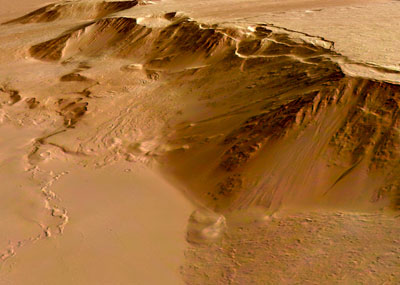Unfortunately, ESA being ESA - they've not gone that far....
CODE
/* FILE DATA ELEMENTS */
RECORD_TYPE = FIXED_LENGTH
RECORD_BYTES = 761
FILE_RECORDS = 9093
LABEL_RECORDS = 13
/* POINTERS TO DATA OBJECTS */
^IMAGE_HEADER = 14
^IMAGE = 24
/* IDENTIFICATION DATA ELEMENTS */
FILE_NAME = "H1089_0000_GR3.IMG"
DATA_SET_ID = "MEX-M-HRSC-5-REFDR-MAPPROJECTED-V1.0"
DETECTOR_ID = MEX_HRSC_GREEN
EVENT_TYPE = "MARS-REGIONAL-STEREO-Vo-Te"
INSTRUMENT_HOST_ID = MEX
INSTRUMENT_HOST_NAME = "MARS EXPRESS"
INSTRUMENT_ID = HRSC
INSTRUMENT_NAME = "HIGH RESOLUTION STEREO CAMERA"
MISSION_NAME = "MARS EXPRESS"
MISSION_PHASE_NAME = MR_Phase_3
PROCESSING_LEVEL_ID = 3
PRODUCT_CREATION_TIME = 2006-02-25T19:37:42.000Z
PRODUCT_ID = "H1089_0000_GR3.IMG"
RELEASE_ID = 0014
REVISION_ID = 0000
/* TIME DATA ELEMENTS */
SPACECRAFT_CLOCK_START_COUNT = "1/0049306128.57946"
SPACECRAFT_CLOCK_STOP_COUNT = "1/0049306423.01508"
START_TIME = 2004-11-23T16:09:25.323Z
STOP_TIME = 2004-11-23T16:13:19.412Z
/* ORBITAL DATA ELEMENTS */
ASCENDING_NODE_LONGITUDE = 205.87
MAXIMUM_RESOLUTION = 90.9 <m/pixel>
FOOTPRINT_POINT_LATITUDE = (27.9346,27.9344,27.9342,27.933,27.9328
,27.9316,27.9314,27.9301,27.9299,
27.9286,27.9283,27.9269,27.9266,27.9252
,27.9247,27.9234,27.9231,27.9228,
27.9215,27.921,27.9196,27.919,27.9167,
27.9164,27.9134,27.913,27.9111,27.9107,
27.9088,27.9084,27.9067,27.9064,27.9044
,27.7339,27.5671,27.4003,26.8988,
26.7313,26.2345,25.9094,25.7463,25.5834
,22.5711,22.417,22.1085,21.7999,21.4907
,21.3364,21.1872,21.0395,20.8898,
20.7401,20.5905,20.4405,20.2907,19.9912
,19.8414,19.5414,19.3913,19.0908,
18.9434,18.7981,18.508,18.3624,18.217,
18.0725,17.9272,17.6366,17.4909,17.3452
,17.1992,17.0528,16.9066,16.7605,
16.6142,16.4681,16.3218,16.0295,15.8825
,15.7404,15.5991,15.4583,15.3155,
15.1743,14.7515,13.7638,13.0574,12.6363
,12.6364,12.6373,12.6375,12.6378,12.638
,12.6423,12.6424,12.6449,12.6464,
12.6465,12.648,27.9346)
FOOTPRINT_POINT_LONGITUDE = (231.495,231.482,231.469,231.392,
231.379,231.301,231.288,231.21,231.197,
231.119,231.106,231.028,231.015,230.936
,230.909,230.844,230.831,230.817,
230.751,230.725,230.659,230.632,230.526
,230.512,230.379,230.365,230.285,
230.271,230.19,230.176,230.109,230.095,
230.088,230.096,230.103,230.11,230.13,
230.136,230.156,230.169,230.174,230.18,
230.279,230.284,230.294,230.304,230.313
,230.319,230.325,230.336,230.34,230.344
,230.348,230.351,230.356,230.365,230.37
,230.379,230.383,230.39,230.393,230.396
,230.403,230.405,230.407,230.414,
230.418,230.425,230.427,230.43,230.431,
230.431,230.432,230.433,230.434,230.435
,230.436,230.44,230.438,230.434,230.434
,230.436,230.429,230.43,230.435,230.446
,230.452,230.456,230.464,230.543,
230.553,230.583,230.593,231.0,231.009,
231.285,231.462,231.472,231.478,
231.495)
ORBIT_NUMBER = 1089
ORBITAL_ECCENTRICITY = 0.574
ORBITAL_INCLINATION = 86.59
ORBITAL_SEMIMAJOR_AXIS = 8632.71
PERIAPSIS_ALTITUDE = 282.96
PERIAPSIS_ARGUMENT_ANGLE = 169.82
PERIAPSIS_TIME = 2004-11-23T16:14:01.000Z
SPACECRAFT_ORIENTATION = (0.0,-1.0,0.0)
^MEX_ORIENTATION_DESC = "MEX_ORIENTATION_DESC.TXT"
SPACECRAFT_POINTING_MODE = ACROSSTRACK
^MEX_POINTING_DESC = "MEX_POINTING_DESC.TXT"
RIGHT_ASCENSION = -1e+32
DECLINATION = -1e+32
OFFSET_ANGLE = -0.62
SPACECRAFT_SOLAR_DISTANCE = 2.41014e+08
TARGET_NAME = MARS
/* CAMERA DATA ELEMENTS */
DETECTOR_TEMPERATURE = 18.1666 <degC>
FOCAL_PLANE_TEMPERATURE = 8.1755 <degC>
INST_CMPRS_NAME = "DISCRETE COSINE TRANSFORMATION (DCT)"
INST_CMPRS_RATIO = 13.4668
INST_CMPRS_QUALITY = 0
INST_CMPRS_QUANTZ_TBL_ID = 0
INSTRUMENT_TEMPERATURE = 10.8262 <degC>
LENS_TEMPERATURE = 9.6028 <degC>
MACROPIXEL_SIZE = 8
MISSING_FRAMES = 0
PIXEL_SUBSAMPLING_FLAG = N
SIGNAL_CHAIN_ID = 2
/* RADIOMETRIC DATA ELEMENTS */
BANDWIDTH = 88.0 <nm>
CENTER_FILTER_WAVELENGTH = 538.0 <nm>
RADIANCE_OFFSET = 0.0 <W*m**-2*sr**-1>
RADIANCE_OFFSET = 0.999522
RADIANCE_SCALING_FACTOR = 0.0263032 <W*m**-2*sr**-1>
RADIANCE_SCALING_FACTOR = 0.0128937
REFLECTANCE_SCALING_FACTOR = 0.00131548
REFLECTANCE_SCALING_FACTOR = 0.000644843
/* DATA OBJECT DEFINITIONS */
OBJECT = IMAGE
INTERCHANGE_FORMAT = BINARY
LINES = 9070
LINE_SAMPLES = 761
SAMPLE_TYPE = UNSIGNED_INTEGER
SAMPLE_BITS = 8
BANDS = 1
BAND_STORAGE_TYPE = BAND_SEQUENTIAL
MAXIMUM = 163
MEAN = 89.6954
MINIMUM = 38
STANDARD_DEVIATION = 7.2111
END_OBJECT = IMAGE
/* MAP OBJECT DEFINITIONS */
OBJECT = IMAGE_MAP_PROJECTION
^DATA_SET_MAP_PROJECTION_CATALOG= "DSMAP.CAT"
A_AXIS_RADIUS = 3396.19 <km>
B_AXIS_RADIUS = 3396.19 <km>
C_AXIS_RADIUS = 3396.19 <km>
CENTER_LATITUDE = 0.0
CENTER_LONGITUDE = 231.0
COORDINATE_SYSTEM_NAME = PLANETOGRAPHIC
COORDINATE_SYSTEM_TYPE = "BODY-FIXED ROTATING"
EASTERNMOST_LONGITUDE = 231.495
FIRST_STANDARD_PARALLEL = "N/A"
LINE_FIRST_PIXEL = 1
LINE_LAST_PIXEL = 9070
LINE_PROJECTION_OFFSET = 16560.6875
MAP_PROJECTION_ROTATION = 0.0
MAP_PROJECTION_TYPE = SINUSOIDAL
MAP_RESOLUTION = 592.746965121889 <pixel/degree>
MAP_SCALE = 0.1 <km/pixel>
MAXIMUM_LATITUDE = 27.9346
MINIMUM_LATITUDE = 12.6363
POSITIVE_LONGITUDE_DIRECTION = EAST
REFERENCE_LATITUDE = "N/A"
REFERENCE_LONGITUDE = "N/A"
SAMPLE_FIRST_PIXEL = 1
SAMPLE_LAST_PIXEL = 761
SAMPLE_PROJECTION_OFFSET = 483.4375
SECOND_STANDARD_PARALLEL = "N/A"
WESTERNMOST_LONGITUDE = 27.9346
END_OBJECT = IMAGE_MAP_PROJECTION
/* IMAGE HEADER DATA ELEMENTS */
OBJECT = IMAGE_HEADER
HEADER_TYPE = VICAR2
INTERCHANGE_FORMAT = ASCII
BYTES = 7610
^DESCRIPTION = "VICAR2.TXT"
END_OBJECT = IMAGE_HEADER
END

